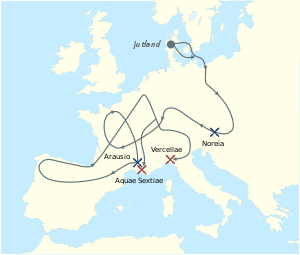Battle of Burdigala
| Battle of Burdigala | |||||||
|---|---|---|---|---|---|---|---|
| Part of the Cimbrian War | |||||||
 Map of the invasion route of the Cimbrian and Teuton territory. |
|||||||
|
|||||||
| Belligerents | |||||||
|
|
Tigurini | ||||||
| Commanders and leaders | |||||||
|
Lucius Calpurnius Piso Caesoninus † |
Divico | ||||||
| Strength | |||||||
| 10,000 | 30,000 warriors | ||||||
| Casualties and losses | |||||||
| High (4,000 taken prisoner) | Relatively low | ||||||
The Battle of Burdigala was a battle of the Cimbrian War that occurred in the year 107 BC. The battle was fought between the forces of the Helvetian Tigurini under the command of Divico, and the forces of the Roman Republic under the command of Lucius Cassius Longinus, Lucius Caesoninus and Gaius Popillius Laenas. Longinus and Caesoninus were killed in the action and the battle resulted in a victory for the Tigurini tribes.
In 112 BC, the Germanic tribes of the Cimbri and the Teutons invaded Roman territory defeating an army under the command of Gnaeus Papirius Carbo in Italy at the Battle of Noreia. The Germanic tribes demanded to be given the right to settle in Roman territory. When denied, the Germanic force marched all the way to Gallia Narbonensis where they defeated another Roman army under the command of Marcus Junius Silanus at an unknown location. It was thereafter that the Germans forged an alliance with the Tigurini tribe and Rome prepared for an invasion of the lower peninsula that did not come.
In 107 BC, the Roman Senate launched another campaign under Lucius Cassius Longinus, Lucius Caesoninus and Lucius Caesoninus, son of Gaius Popillius Laenas, to defend one of their allied tribes. The Tigurinis were able to successfully ambush the Romans and the consul Longinus was killed in the action along with most of his troops. The remaining Roman forces were saved from the same fate by Laenas who was forced to surrender a majority of the army's supplies to the Tigurini in return for permission to retire from the field "under the yoke".
...
Wikipedia
